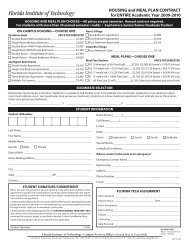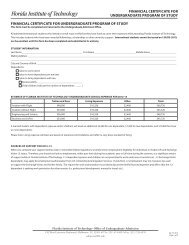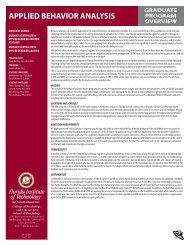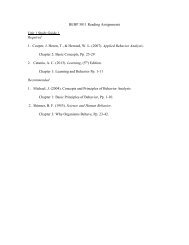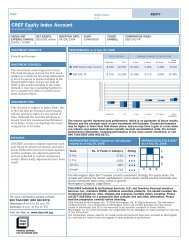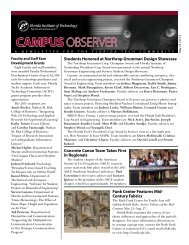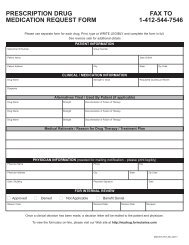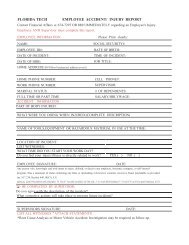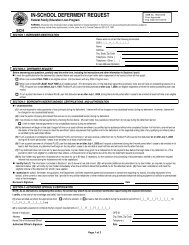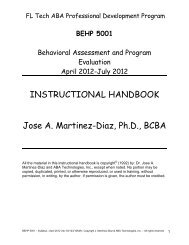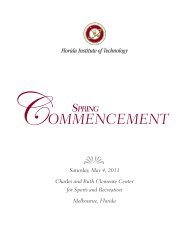2012–2013 UNIVERSITY CATALOG - Florida Institute of Technology
2012–2013 UNIVERSITY CATALOG - Florida Institute of Technology
2012–2013 UNIVERSITY CATALOG - Florida Institute of Technology
Create successful ePaper yourself
Turn your PDF publications into a flip-book with our unique Google optimized e-Paper software.
Microelectronics Laboratory<br />
Susan K. Earles, Associate Pr<strong>of</strong>essor, Electrical and Computer<br />
Engineering, Director. This microelectronics facility is designed<br />
to be a teaching laboratory as well as an advanced research laboratory.<br />
A microelectronics fabrication course is taught to graduate<br />
and undergraduate students. In this course, students complete,<br />
fabricate and test a variety <strong>of</strong> electronic devices such as photovoltaic<br />
devices and hydrogen sensors. Research conducted in the<br />
facility includes polymer-based and silicon-based electronic and<br />
optoelectronic devices. The 3,800-sq.-ft. facility has all support<br />
services needed for modern semiconductor research including a<br />
3,000-sq.-ft. clean room and areas dedicated to circuit testing and<br />
equipment maintenance. Equipment in the laboratory includes<br />
ultraviolet photolithography, diffusion furnaces, a thin-film evaporator,<br />
wet chemistry benches, and measurement and inspection<br />
equipment. The advanced research laboratory presently features a<br />
scanning probe microscope, plasma enhanced deposition and lasers<br />
for teaching and research.<br />
Ralph S. Evinrude Marine Operations Center<br />
Captain Timothy Fletcher, Manager. The center houses small<br />
outboard-powered craft and medium-sized workboats. These vessels<br />
are available to graduate students and faculty for teaching and<br />
research use in the tributaries and the Indian River Lagoon (IRL).<br />
The facility has a variety <strong>of</strong> other resources available and is located<br />
on Crane Creek in Melbourne, approx. 1.5 mile from the main<br />
campus. The IRL is a national estuary and is the most biodiverse<br />
estuary system in North America. The <strong>Florida</strong> Tech national champion<br />
crew team, champion concrete canoe team, Sailing Club and<br />
scientific diving program safety <strong>of</strong>fice are also housed at the center.<br />
Robotics and Spatial Systems Laboratory (RASSL)<br />
Pierre M. Larochelle, Ph.D., Assistant Dean, College <strong>of</strong><br />
Engineering and Pr<strong>of</strong>essor, Mechanical Engineering, Director.<br />
RASSL is dedicated to the development <strong>of</strong> robotic mechanical systems<br />
that generate spatial (i.e., 3-dimensional) motion and force<br />
transmission. RASSL seeks to advance the design methodologies<br />
for these challenging systems as well as techniques for their use<br />
in industrial and consumer applications. Equipment includes a<br />
Motoman SV3 XRC robot, an Adept/Mobile Robotics PowerBOT<br />
and several systems developed by RASSL.<br />
Vero Beach Marine Laboratory (VBML)<br />
Junda Lin, Ph.D., Pr<strong>of</strong>essor, Biological Sciences, Director.<br />
VBML is located on four acres <strong>of</strong> oceanfront property in nearby<br />
Vero Beach. This facility serves as a field station for the university<br />
in support <strong>of</strong> research and teaching in the marine sciences. The<br />
beachfront location <strong>of</strong> VBML provides ready access to field study<br />
sites for work on the biology <strong>of</strong> coastal organisms and for studies<br />
<strong>of</strong> physical and geological processes <strong>of</strong> the coastal zone. Major<br />
research efforts at the laboratory are related to mariculture and<br />
marine biology/ecology. A two-story building, equipped with seawater<br />
tables and a flow-through system, supports research on mariculture<br />
and ecology <strong>of</strong> marine organisms. Several greenhouses and<br />
large tank systems are available for studying aquaculture, behavior<br />
and ecology <strong>of</strong> marine animals. Classrooms, <strong>of</strong>fices and dry laboratory<br />
facilities are provided in the main laboratory building.<br />
Wind and Hurricane Impacts Research Laboratory (WHIRL)<br />
Jean-Paul Pinelli, Ph.D., P.E., Pr<strong>of</strong>essor, Civil Engineering,<br />
Director. WHIRL is dedicated to the study <strong>of</strong> the effects and<br />
impacts <strong>of</strong> windstorms including hurricanes, tornadoes and<br />
thunderstorms, and other related meteorological hazards (e.g.,<br />
flooding and tidal surges) on the natural environment and<br />
manmade structures. The laboratory involves a multidisciplinary<br />
team <strong>of</strong> engineers, scientists and business experts. It takes<br />
advantage <strong>of</strong> a geographic location in the heart <strong>of</strong> <strong>Florida</strong>’s Space<br />
Coast to serve the needs <strong>of</strong> industry, government and the public in<br />
wind hazard mitigation. The laboratory’s activities include research<br />
on mitigation <strong>of</strong> losses <strong>of</strong> life, property and the environment;<br />
education <strong>of</strong> the public through dissemination <strong>of</strong> information;<br />
and the development <strong>of</strong> a multidisciplinary program <strong>of</strong> study<br />
focused on wind engineering and wind-related socioeconomic<br />
studies and analyses. Research topics in the laboratory include<br />
action <strong>of</strong> strong winds and storm surges on structures; evaluation<br />
<strong>of</strong> codes, standards and retr<strong>of</strong>itting techniques for buildings and<br />
infrastructure systems; risk assessment for existing structures,<br />
coastal erosion, sediment transport and environmental damage due<br />
to storm surges and floods; development <strong>of</strong> remote sensing tools for<br />
assessing and monitoring hurricane damage, wind speed and flood<br />
levels; fundamental wind and meteorological research; wind tunnel<br />
modeling and testing; and statistical studies, analysis <strong>of</strong> economic<br />
impacts and development <strong>of</strong> potential damage maps for hurricane<br />
hazards in <strong>Florida</strong>.<br />
Institution Overview 15



